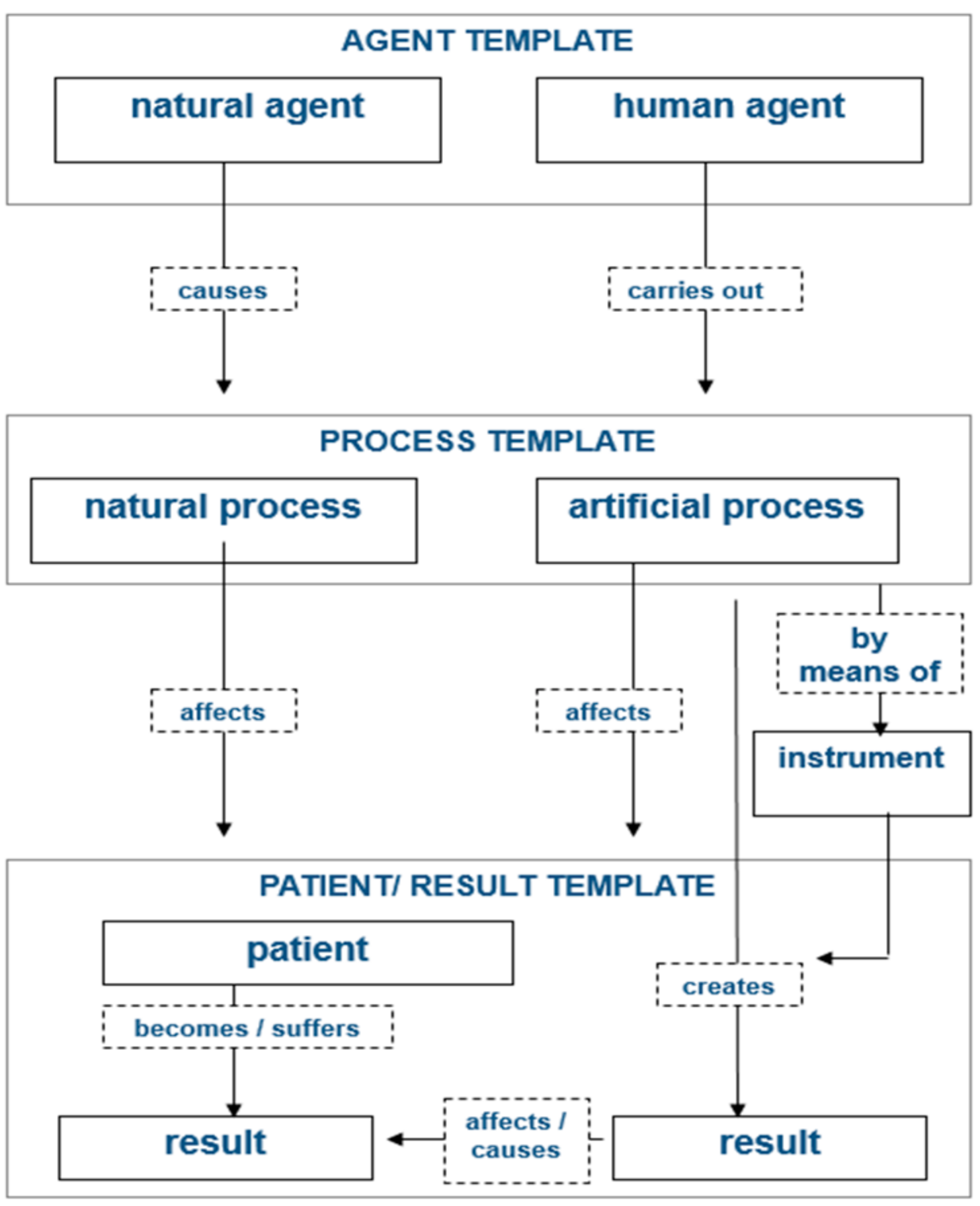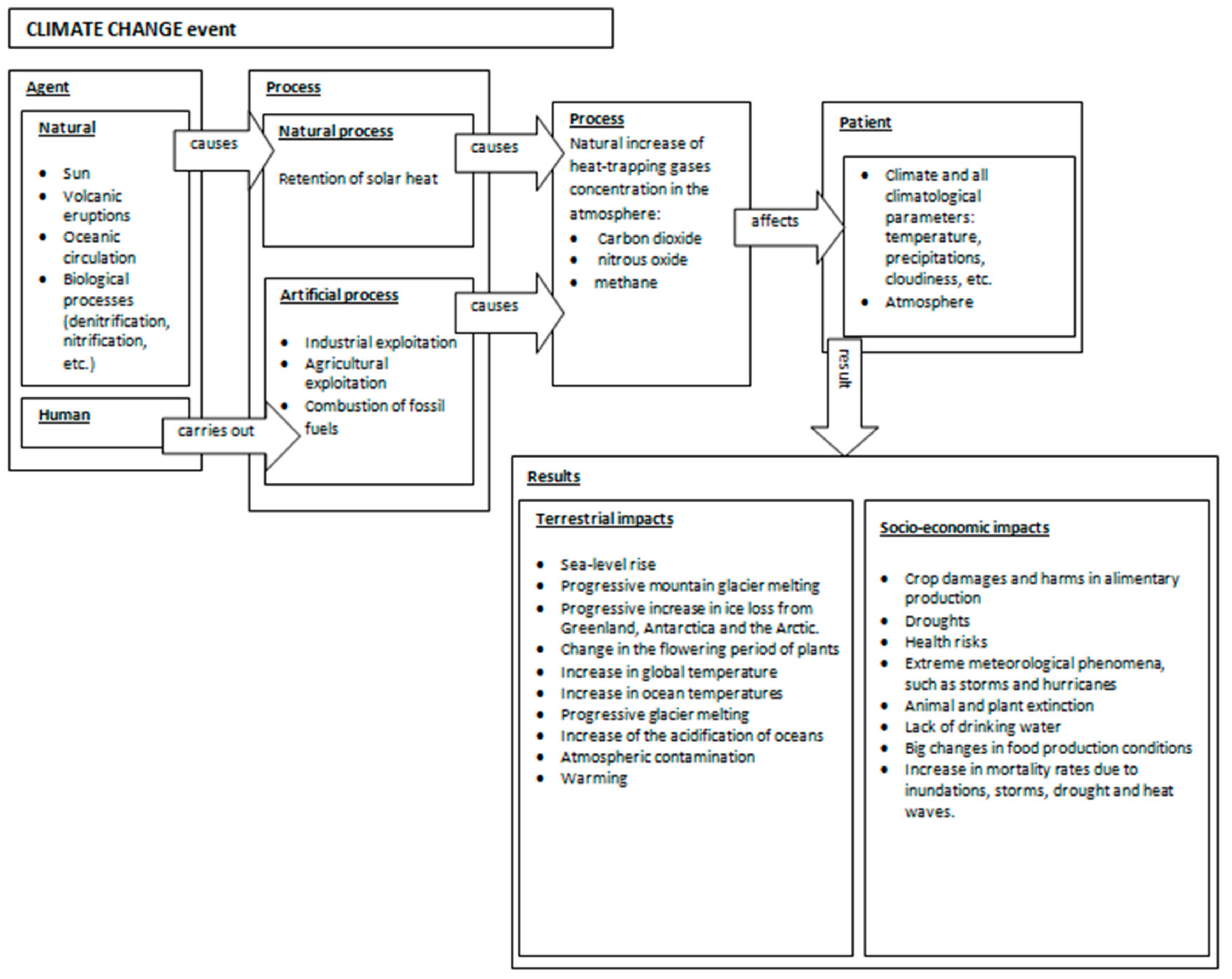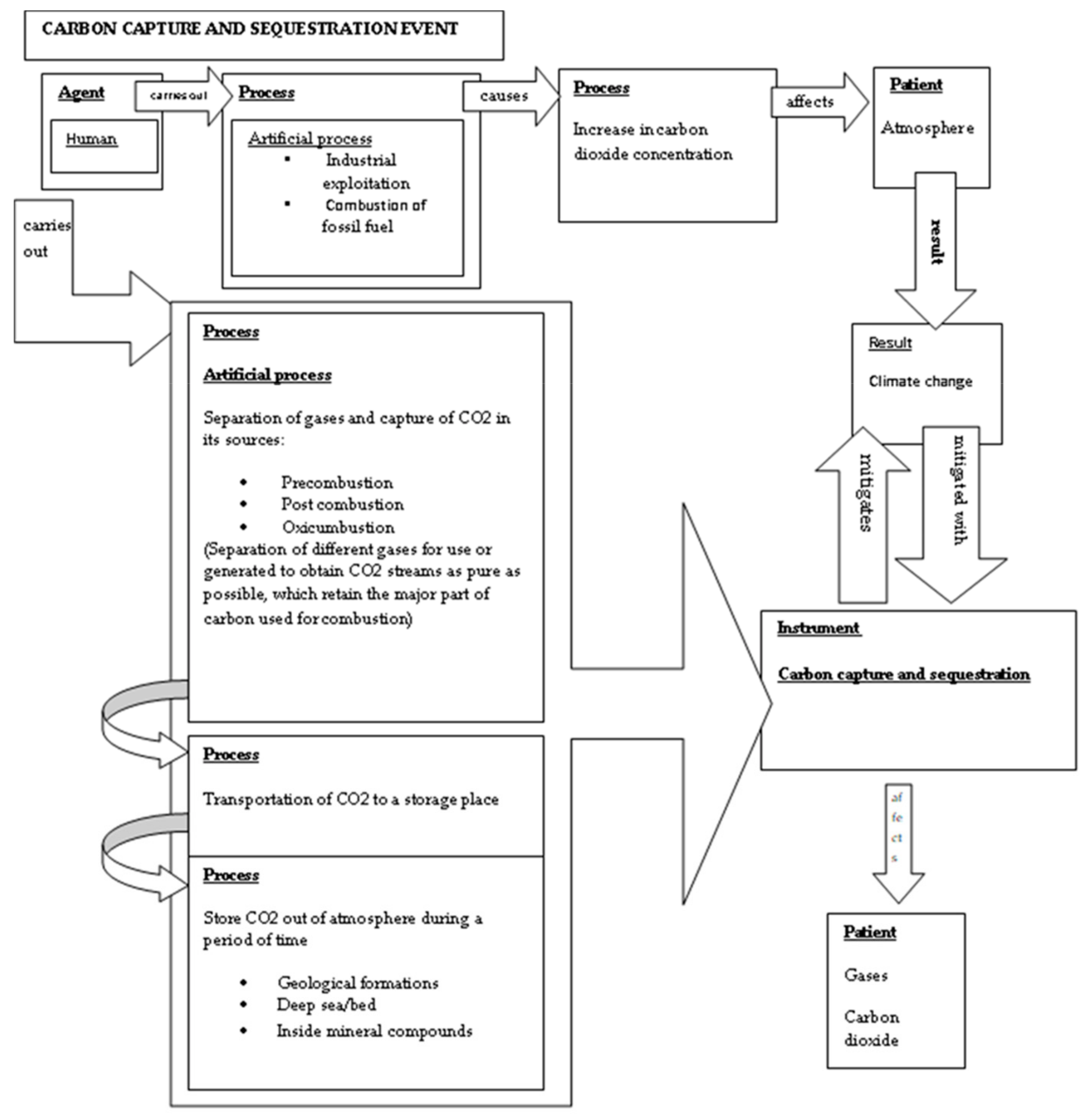The ‘Carbon Capture’ Metaphor: An English-Arabic Terminological Case Study
Abstract
:1. Introduction
2. Materials and Methods
2.1. EcoLexicon and the Environmental Event
2.2. Corpus Selection and Description
2.3. Candidate Metaphorical Terms and the CARBON CAPTURE and SEQUESTRATION Event
- Examples (1.a), (1.b), (1.c) and (1.d.) show how the CCS appears in context as ‘carbon capture and sequestration’ or ‘carbon capture and storage’.
- “… is one step in the process of carbon capture and sequestration (CCS), and involves …¨
- “… Carbon Capture and Sequestration (CCS) is a set of …”
- “… sequestration techniques such as carbon capture and storage (CCS) will be able to reduce the…”
- “…systems or bioenergy coupled with carbon capture and sequestration setups. This poses an…”
- 2.
- Carbon capture and sequestration (CCS) is a set of technologies that can greatly reduce carbon dioxide emissions from new and existing coal- and gas-fired power plants, industrial processes, and other stationary sources of carbon dioxide.
- 3.
- Carbon Capture and Storage (CCS). A suite of technologies exists that allows for CO2 from the combustion or gasification of coal and other fossil fuels to be captured rather than released to the atmosphere. Once captured, CO2 from fossil fuel use can be injected into and permanently sequestered in underground geologic formations.
- 4.
- It is a three-step process that includes the capture of carbon dioxide from power plants or industrial sources; transport of the captured and compressed carbon dioxide (usually in pipelines); and underground injection and geologic sequestration, or permanent storage, of that carbon dioxide in rock formations that contain tiny openings or pores that trap and hold the carbon dioxide.
3. Results and Discussion
3.1. Metaphorical Projection of CARBON CAPTURE AND SEQUESTRATION in English
- 5.
- (…) we would employ a method that is receiving increasing attention: capturing carbon dioxide and storing, or sequestering, it underground rather than releasing it into the atmosphere. Nothing says that CO2 must be emitted into the air (Socolow 2005a, p. 50).
- 6.
- Carbon Capture and Storage (CCS), a suite of technologies exists that allows for CO2 from the combustion or gasification of coal and other fossil fuels to be captured rather than released to the atmosphere (Smith 2011, p. 28).
3.2. Metaphorical Projection of CARBON CAPTURE AND SEQUESTRATION in Arabic
ثمة استراتيجية يمكن ان تجمع بين حجز انبعاث اتثنائياكسيدالكربونمنمحطاتتوليدالطاقةالتيتعملبالفحموحقنهابعدذلكفيالتكويناتالجيولوجيةلخزنهافتراتطويلة.ويمكن انتسهم هذهالاستراتيجية بشكل ملموس في الحد من زيادة تركيز ثنائي اكسيد الكربون في الغلاف الجوي. تعد التقانات المنخفضة الكلفة التي تستهدف الحصول على ثنائي اكسيد الكربون في محطات الطاقة وزيادة الخبرة في حقن ثنائي اكسيد الكربون لتجنب تسربها لسطح الارض من العواملالاساسية في نجاحالمشاريع الكبرى لحجز ثنائي اكسيد الكربون وخزنه.
- 8.
- [thammata istra:ti:jya yumkin an tajmac bayn inbica:tha:t thuna:?i: ?uksi:d al karbwn min mahata:t tawli:d atta:qa allati: tacmal bilfahm wahaqniha: bacd dha:likfi: attakwi:na:t al-jiywlwjyya likhazniha: fatara:t tawi:la. Wayumkin an tus’him ha:dhih al-istra:tyjyya bishakl malmu:s fi: alhadd min zya:dat thuna:?i: ?uksi:d al karbwn fi: al-ghila:f al-jawwy. Tucadd al-taqa:na:t al-munkhafidat al-kulfaallati: tastahdif al-husu:l cala: thuna:?i: ?uksi:d al karbwn fi: mahatta:t al-ta:qa wa zya:dat al-khibra fi: haqn thuna:?i: ?uksi:d al karbwn litajannub tasarrubihi li:sat’h al-ard min al-cawa:mil al-asa:syya fi: naja:h al-masha:ri:c al-kubra: lihajz thuna:?i: ?uksi:d al karbwn wakhaznih][There is a strategy that consists of the imprisonment of carbon dioxide emissions from coal power plants and its injection afterwards in geological formations to store it fora long period of time. This strategy may noticeably help in the reduction of the concentration of carbon dioxide in the atmosphere. It is a low cost technology which aims at obtaining carbon dioxide from energy generation stations. It also aims at increasing the expertise in carbon dioxide injection to avoid infiltrations. These two objectives are considered the main elements for the success of big projects to imprison and storage carbon dioxide].
4. Conclusions
Author Contributions
Funding
Conflicts of Interest
Appendix A
| Arabic Alphabet | Symbol |
|---|---|
| ء | ʔ |
| ث | th |
| ج | j |
| ح | h |
| خ | kh |
| ذ | dh |
| ز | z |
| ش | sh |
| ص | s |
| ض | d |
| ط | t |
| ظ | TH |
| ع | c |
| غ | gh |
| ق | q |
| وَ | w |
| يَ | y |
| (فتحة) َ | a |
| (ضمة) | u |
| (كسرة) ِ | i |
| مد طويل ا/ى | a: |
| ضمة طويلة و | u: |
| كسرة طويلة ي | i: |
| Diphthongs)أصوات علة مركبة) | aw |
| ay |
References
- Abdullah, Sharmini, and Mark Shuttleworth. 2013. Metaphors in the translation of English technical texts into Malay: A preliminary study. Journal of Asian Scientific Research 3: 608–29. [Google Scholar]
- Bert, Metz, Davidson Ogunlade, Heleen de Coninck, Manuela Loos, and Leo Meyer, eds. 2005. Carbon Dioxide Capture and Storage. Cambridge: Cambridge University Press, Available online: https://www.ipcc.ch/report/carbon-dioxide-capture-and-storage/ (accessed on 22 February 2018).
- Boquera Matarredona, María. 2005. Las Metáforas en Textos de Ingeniería Civil: Estudio Contrastivo Español-Inglés. Ph.D. Thesis, Universitat de Valencia, Valencia, Spain, October 5. [Google Scholar]
- Bordet, Geneviève. 2016. Counteracting domain loss and epistemicide in specialized discourse: A case study on the translation of Anglophone metaphors to French. Publications 4: 18. [Google Scholar] [CrossRef]
- Buendía Castro, Miriam, and Jose Manuel Ureña Gómez-Moreno. 2010. ¿Cómo diseñar un corpus de calidad? Parámetros de evaluación. Sendebar 21: 165–80. [Google Scholar]
- Faber, Pamela. 2012. A Cognitive Linguistics View of Terminology and Specialized Language. Berlin (Boston): De Gruyter Mouton. [Google Scholar]
- Faber, Pamela. 2015. ‘Frames as a framework for Terminology’. In Handbook of Terminology. Edited by Hendrik J. Kockaert and Frieda Steurs. Amsterdam and Philadelphia: John Benjamins, pp. 14–33. [Google Scholar]
- Haddad, Amal, and Silvia Montero-Martínez. 2019. ‘Radiative Forcing’ Metaphor: An English-Arabic Terminological and Cultural Case Study. International Journal of Arabic-English Studies 19: 139–58. [Google Scholar]
- Huang, Carolina. 2005. A Metáfora no Texto Científico de Medicina: Um Estudo Terminológico da Linguagem Sobre AIDS. Master’s thesis, Universida de Federal do Rio Grande do Sul, Porto Alegre, Brazil. [Google Scholar]
- Hultgren, Anna Kristina. 2013. Lexical borrowing from English into Danish in the Sciences: An empirical investigation of ‘domain loss’. International Journal of Applied Linguistics 23: 166–82. [Google Scholar] [CrossRef]
- Lakoff, George. 1993. A contemporary theory of metaphor. In Metaphor and Thought. Edited by Ortony Andrew. Cambridge: Cambridge University Press, pp. 202–51. [Google Scholar]
- Lakoff, George, and Mark Johnson. 2003. Metaphors We Live By. Chicago and London: The University of Chicago Press. [Google Scholar]
- López-Rodríguez, Clara Inés, Pamela Faber, Pilar León Araúz, Juan Antonio Prieto Velasco, and Maribel Tercedor. 2010. La terminología basada en marcos y su aplicación a las ciencias ambientales: Los Proyectos MARCOCOSTA y ECOSISTEMA. Arena Romanistica 7: 52–74. [Google Scholar]
- Merakchi, Khadidja. 2017. The Translation of Metaphors in Popular Science from English into Arabic in the domain of Astronomy and Astrophysics. Ph.D. Thesis, University of Surrey, Guildford, UK, August 31. [Google Scholar]
- Merakchi, Khadidja, and Margaret Rogers. 2013. The translation of culturally bound metaphors in the genre of popular science articles: A corpus-based case study from scientific American translated into Arabic. Intercultural Pragmatics 10: 341–72. [Google Scholar] [CrossRef]
- Montero-Martínez, Silvia. 2008. Tidying up tides: Modelling coastal processes in terminology management. Paper Presented at XVIII FIT 2008 World Congress of Shanghai, Shangahai, China, August 4–7. [Google Scholar]
- Montero-Martínez, Silvia, A. Fuertes-Olivera Pedro, and García de Quesada Mercedes. 2001. The translator as ‘Language Planner’: Syntactic calquing in an English-Spanish technical translation of chemical engineering. Meta: Journaldes Traducteurs/Meta: Translators’ Journal 46: 687–98. [Google Scholar] [CrossRef]
- Ruiz de Mendoza, Francisco José. 2017. Conceptual complexes in cognitive modeling. Revista Española de Linguistica Aplicada 30: 297–322. [Google Scholar] [CrossRef]
- Shuttleworth, Mark. 2016. Studying Scientific Metaphor in Translation: An Inquiry into Cross-Lingual Translation Practices. New York and London: Routledge. [Google Scholar]
- Smith, Sandy. 2011. Climate Change 101: Understanding and Responding to Global Climate Change Overview Science and Impacts Adaptation Technological Solutions Business Solutions International Action. Arlington: PEW Center on Global Climate Change: Available online: https://es.calameo.com/read/00057071332f28f1d59a1 (accessed on 22 February 2018).
- Socolow, Robert. 2005a. Can We Bury Global Warming? Pumping carbon dioxide underground to avoid warming the atmosphere is feasible, but only if several key challenges can be met. Scientific American 293: 49–55. Available online: https://www.scientificamerican.com/ (accessed on 22 February 2018).
- Socolow, Robert. 2005b. هل يمكننا دفن الاحترار العالمي؟ لتجنب احترار الغلاف الجوي يمكن ضخ ثنائي أكسيد الكربون في باطن الأرض، غير أن ذلك يتطلب منا مواجهة تحديات جساما [hal yumkinuna: dafn al-ihtira:r al-ca:lami: litajannub ihtira:ral-ghila:f al-jawwi: yumkin dakh thuna?i: ?uksi:d al-karbwn fi: batin al-ard ghayr an dha:lik yatatallab minna mwajahat tahadya:t jisa:m]. Majallat Al-Oloom21. Available online: http://www.oloommagazine.com/Articles/Archieve.aspx (accessed on 22 February 2018).
- Ureña Gómez-Moreno, Jose Manuel. 2012. Conceptual types of terminological metaphors in marine biology. An English-Spanish contrastive analysis from an experientialist perspective. In Metaphor in Use: Context, Culture, and Communication. Edited by Fiona MacArthur, José Luis Oncins-Martínez, Manuel Sánchez García and Ana Marí Piquer Píriz. Amsterdam: John Benjamins Publishing, pp. 239–60. [Google Scholar]
- Ureña Gómez-Moreno, Jose Manuel. 2015. Refining the understanding of novel metaphor in specialised language discourse. Terminology 22: 1–29. [Google Scholar]
- Ureña Gómez-Moreno, Jose Manuel, Faber Pamela, and Buendía Castro Miriam. 2013. Frame blending in specialized language: Harmfulalgalbloom. Terminology 19: 175–201. [Google Scholar]
| 1 | Transliteration is provided in italics between square brackets. Transliteration symbols can be found in Appendix A. |
| 2 | Translation into English between square brackets. |



| Word | Frequency | |
|---|---|---|
| 1. | capture | 43 |
| 2. | captured | 9 |
| POLICE SEIZURE Frame |
|---|
| Capture (PROCESS) |
| Imprisonment (PROCESS) |
| Transportation (PROCESS) |
| Liberation (PROCESS) |
| Police (ENTITY) (AGENT) |
| Criminal (ENTITY) (PATIENT) |
| Judge (ENTITY) (AGENT) |
| Crime (PROCESS) |
| Duration (ATTRIBUTE: TIME) |
| Prison (ENTITY) (LOCATION) |
| Victim(ENTITY) (PATIENT) |
| Police Car (ENTITY) (INSTRUMENT) |
| FEs of POLICE SEIZURE | FEs of CARBON CAPTURE AND SEQUESTRATION | |
|---|---|---|
| 1. | Capture (PROCESS) | Carbon Capture |
| 2. | Imprisonment (PROCESS) | Storage/Sequestration |
| 3. | Transportation (PROCESS) | Transportation |
| 4. | Liberation (PROCESS) | Release |
| 5. | Police (ENTITY) (AGENT) | Scientist |
| 6. | Criminal (ENTITY) (PATIENT) | Carbon-Dioxide |
| 7. | Crime (PROCESS) | Global Warming/Climate-Change |
| 8. | Duration (ATTRIBUTE: TIME) | Duration (Temporary/Permanent) |
| 9. | Prison (ENTITY) (LOCATION) | Underground/Sea-Bed |
| 10. | Victim(ENTITY) (PATIENT) | Atmosphere/Earth-System |
| 11. | Police Car (ENTITY) INSTRUMENT) | Pipelines |
| 12. | Criminal (AGENT) | CO2 |
| Lexical Constructions in English and Arabic | Fes Police Seizure | |
|---|---|---|
| 1. | ‘capture and sequestration of carbon dioxide’’’اسر ثنائي اكسيد الكربون وفصله‘;‘احتجاز ثنائي اكسيد الكربون وتخزينه’[asrthuna:?i: ?uksi:d al-karbwnwafasluh]; [ihtija:zthuna:?i: ?uksi:d al-karbwnwatakhzi:nih][imprisonment of carbon dioxide and its separation; imprisonment of carbon dioxide and its storage] | Capture—Criminal—Imprisonment |
| 2. | ‘the sequestration of greenhouse gases such ascarbondioxide’‘احتباس غازات الدفيئة ولاسيما ثاني اكسيد الكربون’[ihtiba:s gha:za:t al-dafy?a wala:siyama: thuna:?i: ?uksi:d al-karbwn][the confinement of global greenhouse gases, above all, carbon dioxide] | Criminal—Imprisonment |
| 3. | ‘storing captured carbon dioxide underground’‘’امتصاص الغاز الكربوني وحجزه في تلك الصخور’[imtisa:s al-ga:z al-karbwny wahajzih fi: tilka al-sukhu:r][the absorption of the carbonic gas and its imprisonment in those rocks] | Imprisonment—Capture—Criminal-Prison |
| 4. | ‘carbon sequestration’‘عزل الكربون’; ‘تنحية الكربون’[tanhiyat al-karbwn]; [cazl al-karbwn][the isolation of carbon]; [the insulation of carbon] | Imprisonment—Criminal |
© 2019 by the authors. Licensee MDPI, Basel, Switzerland. This article is an open access article distributed under the terms and conditions of the Creative Commons Attribution (CC BY) license (http://creativecommons.org/licenses/by/4.0/).
Share and Cite
Haddad Haddad, A.; Montero-Martínez, S. The ‘Carbon Capture’ Metaphor: An English-Arabic Terminological Case Study. Languages 2019, 4, 77. https://doi.org/10.3390/languages4040077
Haddad Haddad A, Montero-Martínez S. The ‘Carbon Capture’ Metaphor: An English-Arabic Terminological Case Study. Languages. 2019; 4(4):77. https://doi.org/10.3390/languages4040077
Chicago/Turabian StyleHaddad Haddad, Amal, and Silvia Montero-Martínez. 2019. "The ‘Carbon Capture’ Metaphor: An English-Arabic Terminological Case Study" Languages 4, no. 4: 77. https://doi.org/10.3390/languages4040077
APA StyleHaddad Haddad, A., & Montero-Martínez, S. (2019). The ‘Carbon Capture’ Metaphor: An English-Arabic Terminological Case Study. Languages, 4(4), 77. https://doi.org/10.3390/languages4040077





